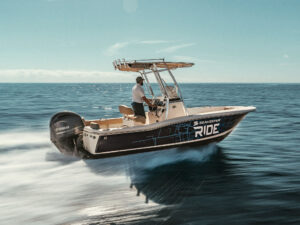
Ever since C. Raymond Hunt developed the deep-V hull in the 1960s, this hull type has been regarded as the de facto hull form for bluewater boating. Builders of everything from small center-consoles to giant canyon runners embraced the design as the way to get anglers offshore more comfortably. But with the recent rise of mega-center-consoles, step-hulls have taken center stage, leading some fishing-boat buyers to ask, “Which is the best design for me?” Each style has its pros and cons, and each type of hull might be the best for you depending on how you use your boat. Here, then, is a breakdown of the different characteristics of step-hulls versus deep-Vs.
The Deep-V
True deep-V boats have a couple of main design characteristics that make them ideal for running in rough waters. The first is the steep deadrise—the angle of the hull as it flares out from the keel to the chines. True deep-Vs have a sharper deadrise of between 21 and 24.5 degrees at the transom, compared with 15 to 20 degrees of transom deadrise of more-moderate V-hull boats. This deeper deadrise, when combined with a narrower beam and a sharper forward entry at the bow, helps deep-V hulls carve through the water rather than slam through it or skim over the top of it. Offshore deep-Vs also typically employ hard chines carried far forward and flared bows to knock down spray and create a drier ride. Many deep-V builders use a 3-to-1 length-to-beam ratio that helps them act like a carving knife through chop and rough swells. At planing speeds, deep-V hulls also have excellent lateral stability and tend to track straight rather than wander, or “surf.” In short, a deep-V hull has more hull in the water at all times.
The drawbacks of deep-Vs are well-documented at this point. For one, they are not particularly efficient, meaning it takes more horsepower to get up on plane and stay there at speed. They tend to squat a little more out of the hole when climbing on plane and need more attention to engine trim as well as tabs to achieve optimal performance while running in different sea conditions. Deep-Vs with narrower beams also tend to roll more while at anchor or while adrift or trolling, especially when subjected to a beam sea. The deep-V creates a pendulum effect, which could make some crew uncomfortable or even seasick.
These and a few other factors have resulted in builders looking to step-hull designs in recent years. Advancements in outboard power have obliterated the limitations of the center-console form. Whereas years ago, center-consoles tended to max out at 28 to 32 feet in length, with at most twin 200 hp outboards, nowadays, 50- to 60-foot center-consoles with quad 600 hp outboards on the transom have become commonplace. Boat buyers have also come to expect faster top speeds along with more creature comforts on board and more seating space, leading to wider-beamed boats. For many builders, the design solution to these developments has been to add steps.

The Step-Hull
Step-hulls actually predate deep-Vs in the annals of boating history, tracing back to hydroplane racing boats in the early 1900s. They started to resurface in recreational-boat building in the 1980s and 1990s, typically in offshore performance boats. Another celebrated marine architect, Michael Peters, patented a step-hull design in 1982 called the Stepped Vee Ventilated Tunnel, ushering it into modern boatbuilding. Other designers followed suit and over the years have worked to weed out the kinks associated with step-hulls to develop the modern-day models that we see today.
What is a step? It’s a notch cut into the hull bottom that extends to the outer chines of the running surface. It breaks up the flow of water as it travels aft, ventilating it with air and reducing friction. This allows the engines to push the boat through the water with less resistance. This is the No. 1 benefit of a step design: It creates big gains in efficiency so that you can attain higher speeds with less power. As fishing boats continually grow bigger and heavier and have to absorb the added weight of larger engines, this is a major advantage.
Step-hulls also provide a better running attitude. A properly designed version, which often features two steps in tandem along the running surface, will help the boat attain a more level ride with less need for trim while running in different sea conditions.
What are the drawbacks? At lower speeds, particularly while trolling or at displacement speed in a no-wake zone, step-hulls are actually less efficient because the vented chines are fully submersed in the water and can’t ventilate the hull bottom. Steps are also tricky to get right—especially today with most bigger boats using twin steps. They have to be designed into the optimal spots along the hull bottom to properly ventilate the running surface at speed, without compromising stability.
Some early adopters struggled with issues such as bow stuffing or catching the edge of the hull—the chine—in turns. In another noted quirk, you used to have to leave the engines trimmed up in hard turns, which runs counter to the technique of trimming the engines down while turning in a deep-V. A lot of first-time step drivers used to experience the dreaded stuffing or catching a chine when “tucking in.”
Thankfully, the best builders have had a few decades to iron out the kinks, and most step-hulls are now as predictable to handle as traditional moderate and deep-V hulls.
So which type of boat is right for you? That depends on what you want out of your boat. The deep-V is still the most tried-and-true hull for running offshore in rough conditions, but with a step-hull, you might be able to get there faster and with a little more fuel left over for the ride home.










